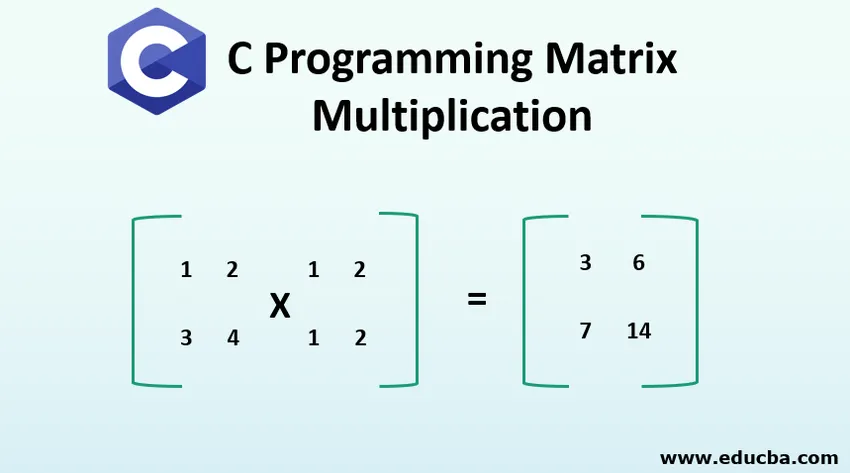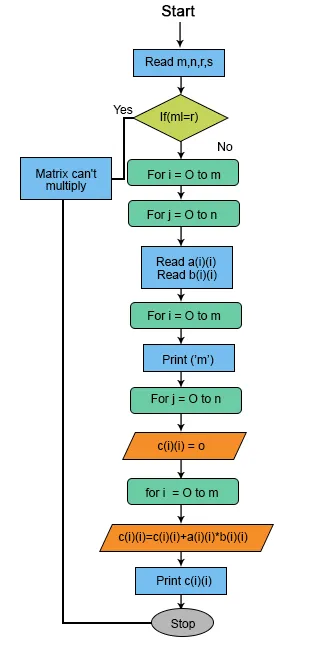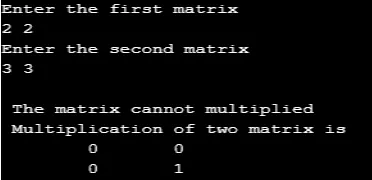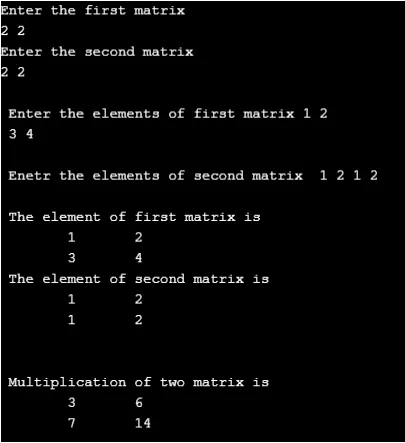
Wprowadzenie do mnożenia macierzy w programowaniu C.
W artykule C Programowanie mnożenia macierzy macierz jest siatką służącą do przechowywania danych w formacie strukturalnym. Jest często używany z tabelą, w której dane są reprezentowane w poziomych rzędach i pionowych kolumnach. Macierze są często używane w językach programowania i służą do przedstawiania danych w strukturze graficznej. W programowaniu, jeśli użytkownik chce pomnożyć, dodać, odjąć i podzielić dwie macierze, najpierw należy zadeklarować kolejność macierzy. Po zadeklarowaniu kolejności macierzy dla pierwszej i drugiej macierzy, elementy (dane wejściowe) macierzy muszą zostać wprowadzone przez użytkownika. Jeśli kolejność macierzy nie jest proporcjonalna do siebie, zostanie wyświetlony komunikat o błędzie, który programista wszczepi w instrukcji warunku. Jeśli macierz zawiera tylko jeden wiersz, wówczas nazywa się go wektorem wiersza, a jeśli zawiera tylko jedną kolumnę, nazywany jest wektorem kolumnowym.
Macierz zawierająca tę samą liczbę wierszy i kolumn, a następnie nazywana jest macierzą kwadratową. Matryca służy do przechowywania grupy powiązanych danych. Niektóre języki programowania są używane do obsługi macierzy jako typu danych, który oferuje większą elastyczność niż tablica statyczna. Zamiast zapisywać wartości w macierzy, można je zapisać jako indywidualną zmienną, program może uzyskać dostęp do danych i wykonywać operacje na danych bardziej wydajnie. W programowaniu C mnożenia macierzy są wykonywane przy użyciu tablic, funkcji, wskaźników. Dlatego omówimy algorytm mnożenia macierzy wraz ze schematem blokowym, którego można użyć do napisania kodu programowania do mnożenia macierzy 3 × 3 w języku wysokiego poziomu. To szczegółowe wyjaśnienie pomoże ci przeanalizować działający mechanizm mnożenia macierzy i pomoże zrozumieć, jak pisać kod.
Algorytm mnożenia macierzy programowania C
Krok 1: Uruchom program.
Krok 2: Wprowadź wiersz i kolumnę pierwszej (a) matrycy.
Krok 3: Wprowadź wiersz i kolumnę drugiej (b) matrycy.
Krok 4: Wprowadź elementy pierwszej (a) matrycy.
Krok 5: Wprowadź elementy drugiej (b) matrycy.
Krok 6: Wydrukuj elementy pierwszej (a) macierzy w postaci macierzy.
Krok 7: Wydrukuj elementy drugiej (b) macierzy w postaci macierzy.
Krok 8: Ustaw pętlę do rzędu.
Krok 9: Ustaw wewnętrzną pętlę do kolumny.
Krok 10: Ustaw kolejną wewnętrzną pętlę do kolumny.
Krok 11: Pomnóż pierwszą (a) i drugą (b) macierz i zapisz element w trzeciej macierzy (c)
Krok 12: Wydrukuj ostateczną matrycę.
Krok 13: Zatrzymaj program.
Schemat blokowy mnożenia macierzy

Przykład mnożenia macierzy programowania C
Program C wykonuje mnożenie macierzy, spójrzmy na kilka przykładów.
Kod:
#include
void main()
(
int a(25)(25), b(25)(25), c(25)(25), i, j, k, r, s;
int m, n;
printf("Enter the first matrix\n");
scanf("%d%d", &m, &n);
printf("Enter the second matrix\n");
scanf("%d%d", &r, &s);
if(m!=r)
printf("\n The matrix cannot multiplied");
else
(
printf("\n Enter the elements of first matrix ");
for(i= 0;i (
for(j=0;j scanf("\t%d", &a(i)(j));
)
printf("\n Enetr the elements of second matrix ");
for(i=0;i (
for(j=0;j scanf("\t%d", &b(i)(j));
)
printf("\n The element of first matrix is");
for(i=0;i (
printf("\n");
for(j=0;j printf("\t%d", a(i)(j));
)
printf("\n The element of second matrix is");
for(i=0;i (
printf("\n");
for(j=0;j printf("\t%d", b(i)(j));
)
for(i=0;i (
printf("\n");
for(j=0;j (
c(i)(j)=0;
for(k=0;k c(i)(j)=c(i)(j)+a(i)(k)*b(k)(j);
)
)
)
printf("\n Multiplication of two matrix is");
for(i=0;i (
printf("\n");
for(j=0;j printf("\t%d", c(i)(j));
)
)#include
void main()
(
int a(25)(25), b(25)(25), c(25)(25), i, j, k, r, s;
int m, n;
printf("Enter the first matrix\n");
scanf("%d%d", &m, &n);
printf("Enter the second matrix\n");
scanf("%d%d", &r, &s);
if(m!=r)
printf("\n The matrix cannot multiplied");
else
(
printf("\n Enter the elements of first matrix ");
for(i= 0;i (
for(j=0;j scanf("\t%d", &a(i)(j));
)
printf("\n Enetr the elements of second matrix ");
for(i=0;i (
for(j=0;j scanf("\t%d", &b(i)(j));
)
printf("\n The element of first matrix is");
for(i=0;i (
printf("\n");
for(j=0;j printf("\t%d", a(i)(j));
)
printf("\n The element of second matrix is");
for(i=0;i (
printf("\n");
for(j=0;j printf("\t%d", b(i)(j));
)
for(i=0;i (
printf("\n");
for(j=0;j (
c(i)(j)=0;
for(k=0;k c(i)(j)=c(i)(j)+a(i)(k)*b(k)(j);
)
)
)
printf("\n Multiplication of two matrix is");
for(i=0;i (
printf("\n");
for(j=0;j printf("\t%d", c(i)(j));
)
)#include
void main()
(
int a(25)(25), b(25)(25), c(25)(25), i, j, k, r, s;
int m, n;
printf("Enter the first matrix\n");
scanf("%d%d", &m, &n);
printf("Enter the second matrix\n");
scanf("%d%d", &r, &s);
if(m!=r)
printf("\n The matrix cannot multiplied");
else
(
printf("\n Enter the elements of first matrix ");
for(i= 0;i (
for(j=0;j scanf("\t%d", &a(i)(j));
)
printf("\n Enetr the elements of second matrix ");
for(i=0;i (
for(j=0;j scanf("\t%d", &b(i)(j));
)
printf("\n The element of first matrix is");
for(i=0;i (
printf("\n");
for(j=0;j printf("\t%d", a(i)(j));
)
printf("\n The element of second matrix is");
for(i=0;i (
printf("\n");
for(j=0;j printf("\t%d", b(i)(j));
)
for(i=0;i (
printf("\n");
for(j=0;j (
c(i)(j)=0;
for(k=0;k c(i)(j)=c(i)(j)+a(i)(k)*b(k)(j);
)
)
)
printf("\n Multiplication of two matrix is");
for(i=0;i (
printf("\n");
for(j=0;j printf("\t%d", c(i)(j));
)
)#include
void main()
(
int a(25)(25), b(25)(25), c(25)(25), i, j, k, r, s;
int m, n;
printf("Enter the first matrix\n");
scanf("%d%d", &m, &n);
printf("Enter the second matrix\n");
scanf("%d%d", &r, &s);
if(m!=r)
printf("\n The matrix cannot multiplied");
else
(
printf("\n Enter the elements of first matrix ");
for(i= 0;i (
for(j=0;j scanf("\t%d", &a(i)(j));
)
printf("\n Enetr the elements of second matrix ");
for(i=0;i (
for(j=0;j scanf("\t%d", &b(i)(j));
)
printf("\n The element of first matrix is");
for(i=0;i (
printf("\n");
for(j=0;j printf("\t%d", a(i)(j));
)
printf("\n The element of second matrix is");
for(i=0;i (
printf("\n");
for(j=0;j printf("\t%d", b(i)(j));
)
for(i=0;i (
printf("\n");
for(j=0;j (
c(i)(j)=0;
for(k=0;k c(i)(j)=c(i)(j)+a(i)(k)*b(k)(j);
)
)
)
printf("\n Multiplication of two matrix is");
for(i=0;i (
printf("\n");
for(j=0;j printf("\t%d", c(i)(j));
)
)#include
void main()
(
int a(25)(25), b(25)(25), c(25)(25), i, j, k, r, s;
int m, n;
printf("Enter the first matrix\n");
scanf("%d%d", &m, &n);
printf("Enter the second matrix\n");
scanf("%d%d", &r, &s);
if(m!=r)
printf("\n The matrix cannot multiplied");
else
(
printf("\n Enter the elements of first matrix ");
for(i= 0;i (
for(j=0;j scanf("\t%d", &a(i)(j));
)
printf("\n Enetr the elements of second matrix ");
for(i=0;i (
for(j=0;j scanf("\t%d", &b(i)(j));
)
printf("\n The element of first matrix is");
for(i=0;i (
printf("\n");
for(j=0;j printf("\t%d", a(i)(j));
)
printf("\n The element of second matrix is");
for(i=0;i (
printf("\n");
for(j=0;j printf("\t%d", b(i)(j));
)
for(i=0;i (
printf("\n");
for(j=0;j (
c(i)(j)=0;
for(k=0;k c(i)(j)=c(i)(j)+a(i)(k)*b(k)(j);
)
)
)
printf("\n Multiplication of two matrix is");
for(i=0;i (
printf("\n");
for(j=0;j printf("\t%d", c(i)(j));
)
)#include
void main()
(
int a(25)(25), b(25)(25), c(25)(25), i, j, k, r, s;
int m, n;
printf("Enter the first matrix\n");
scanf("%d%d", &m, &n);
printf("Enter the second matrix\n");
scanf("%d%d", &r, &s);
if(m!=r)
printf("\n The matrix cannot multiplied");
else
(
printf("\n Enter the elements of first matrix ");
for(i= 0;i (
for(j=0;j scanf("\t%d", &a(i)(j));
)
printf("\n Enetr the elements of second matrix ");
for(i=0;i (
for(j=0;j scanf("\t%d", &b(i)(j));
)
printf("\n The element of first matrix is");
for(i=0;i (
printf("\n");
for(j=0;j printf("\t%d", a(i)(j));
)
printf("\n The element of second matrix is");
for(i=0;i (
printf("\n");
for(j=0;j printf("\t%d", b(i)(j));
)
for(i=0;i (
printf("\n");
for(j=0;j (
c(i)(j)=0;
for(k=0;k c(i)(j)=c(i)(j)+a(i)(k)*b(k)(j);
)
)
)
printf("\n Multiplication of two matrix is");
for(i=0;i (
printf("\n");
for(j=0;j printf("\t%d", c(i)(j));
)
)#include
void main()
(
int a(25)(25), b(25)(25), c(25)(25), i, j, k, r, s;
int m, n;
printf("Enter the first matrix\n");
scanf("%d%d", &m, &n);
printf("Enter the second matrix\n");
scanf("%d%d", &r, &s);
if(m!=r)
printf("\n The matrix cannot multiplied");
else
(
printf("\n Enter the elements of first matrix ");
for(i= 0;i (
for(j=0;j scanf("\t%d", &a(i)(j));
)
printf("\n Enetr the elements of second matrix ");
for(i=0;i (
for(j=0;j scanf("\t%d", &b(i)(j));
)
printf("\n The element of first matrix is");
for(i=0;i (
printf("\n");
for(j=0;j printf("\t%d", a(i)(j));
)
printf("\n The element of second matrix is");
for(i=0;i (
printf("\n");
for(j=0;j printf("\t%d", b(i)(j));
)
for(i=0;i (
printf("\n");
for(j=0;j (
c(i)(j)=0;
for(k=0;k c(i)(j)=c(i)(j)+a(i)(k)*b(k)(j);
)
)
)
printf("\n Multiplication of two matrix is");
for(i=0;i (
printf("\n");
for(j=0;j printf("\t%d", c(i)(j));
)
)#include
void main()
(
int a(25)(25), b(25)(25), c(25)(25), i, j, k, r, s;
int m, n;
printf("Enter the first matrix\n");
scanf("%d%d", &m, &n);
printf("Enter the second matrix\n");
scanf("%d%d", &r, &s);
if(m!=r)
printf("\n The matrix cannot multiplied");
else
(
printf("\n Enter the elements of first matrix ");
for(i= 0;i (
for(j=0;j scanf("\t%d", &a(i)(j));
)
printf("\n Enetr the elements of second matrix ");
for(i=0;i (
for(j=0;j scanf("\t%d", &b(i)(j));
)
printf("\n The element of first matrix is");
for(i=0;i (
printf("\n");
for(j=0;j printf("\t%d", a(i)(j));
)
printf("\n The element of second matrix is");
for(i=0;i (
printf("\n");
for(j=0;j printf("\t%d", b(i)(j));
)
for(i=0;i (
printf("\n");
for(j=0;j (
c(i)(j)=0;
for(k=0;k c(i)(j)=c(i)(j)+a(i)(k)*b(k)(j);
)
)
)
printf("\n Multiplication of two matrix is");
for(i=0;i (
printf("\n");
for(j=0;j printf("\t%d", c(i)(j));
)
)#include
void main()
(
int a(25)(25), b(25)(25), c(25)(25), i, j, k, r, s;
int m, n;
printf("Enter the first matrix\n");
scanf("%d%d", &m, &n);
printf("Enter the second matrix\n");
scanf("%d%d", &r, &s);
if(m!=r)
printf("\n The matrix cannot multiplied");
else
(
printf("\n Enter the elements of first matrix ");
for(i= 0;i (
for(j=0;j scanf("\t%d", &a(i)(j));
)
printf("\n Enetr the elements of second matrix ");
for(i=0;i (
for(j=0;j scanf("\t%d", &b(i)(j));
)
printf("\n The element of first matrix is");
for(i=0;i (
printf("\n");
for(j=0;j printf("\t%d", a(i)(j));
)
printf("\n The element of second matrix is");
for(i=0;i (
printf("\n");
for(j=0;j printf("\t%d", b(i)(j));
)
for(i=0;i (
printf("\n");
for(j=0;j (
c(i)(j)=0;
for(k=0;k c(i)(j)=c(i)(j)+a(i)(k)*b(k)(j);
)
)
)
printf("\n Multiplication of two matrix is");
for(i=0;i (
printf("\n");
for(j=0;j printf("\t%d", c(i)(j));
)
)#include
void main()
(
int a(25)(25), b(25)(25), c(25)(25), i, j, k, r, s;
int m, n;
printf("Enter the first matrix\n");
scanf("%d%d", &m, &n);
printf("Enter the second matrix\n");
scanf("%d%d", &r, &s);
if(m!=r)
printf("\n The matrix cannot multiplied");
else
(
printf("\n Enter the elements of first matrix ");
for(i= 0;i (
for(j=0;j scanf("\t%d", &a(i)(j));
)
printf("\n Enetr the elements of second matrix ");
for(i=0;i (
for(j=0;j scanf("\t%d", &b(i)(j));
)
printf("\n The element of first matrix is");
for(i=0;i (
printf("\n");
for(j=0;j printf("\t%d", a(i)(j));
)
printf("\n The element of second matrix is");
for(i=0;i (
printf("\n");
for(j=0;j printf("\t%d", b(i)(j));
)
for(i=0;i (
printf("\n");
for(j=0;j (
c(i)(j)=0;
for(k=0;k c(i)(j)=c(i)(j)+a(i)(k)*b(k)(j);
)
)
)
printf("\n Multiplication of two matrix is");
for(i=0;i (
printf("\n");
for(j=0;j printf("\t%d", c(i)(j));
)
)#include
void main()
(
int a(25)(25), b(25)(25), c(25)(25), i, j, k, r, s;
int m, n;
printf("Enter the first matrix\n");
scanf("%d%d", &m, &n);
printf("Enter the second matrix\n");
scanf("%d%d", &r, &s);
if(m!=r)
printf("\n The matrix cannot multiplied");
else
(
printf("\n Enter the elements of first matrix ");
for(i= 0;i (
for(j=0;j scanf("\t%d", &a(i)(j));
)
printf("\n Enetr the elements of second matrix ");
for(i=0;i (
for(j=0;j scanf("\t%d", &b(i)(j));
)
printf("\n The element of first matrix is");
for(i=0;i (
printf("\n");
for(j=0;j printf("\t%d", a(i)(j));
)
printf("\n The element of second matrix is");
for(i=0;i (
printf("\n");
for(j=0;j printf("\t%d", b(i)(j));
)
for(i=0;i (
printf("\n");
for(j=0;j (
c(i)(j)=0;
for(k=0;k c(i)(j)=c(i)(j)+a(i)(k)*b(k)(j);
)
)
)
printf("\n Multiplication of two matrix is");
for(i=0;i (
printf("\n");
for(j=0;j printf("\t%d", c(i)(j));
)
)#include
void main()
(
int a(25)(25), b(25)(25), c(25)(25), i, j, k, r, s;
int m, n;
printf("Enter the first matrix\n");
scanf("%d%d", &m, &n);
printf("Enter the second matrix\n");
scanf("%d%d", &r, &s);
if(m!=r)
printf("\n The matrix cannot multiplied");
else
(
printf("\n Enter the elements of first matrix ");
for(i= 0;i (
for(j=0;j scanf("\t%d", &a(i)(j));
)
printf("\n Enetr the elements of second matrix ");
for(i=0;i (
for(j=0;j scanf("\t%d", &b(i)(j));
)
printf("\n The element of first matrix is");
for(i=0;i (
printf("\n");
for(j=0;j printf("\t%d", a(i)(j));
)
printf("\n The element of second matrix is");
for(i=0;i (
printf("\n");
for(j=0;j printf("\t%d", b(i)(j));
)
for(i=0;i (
printf("\n");
for(j=0;j (
c(i)(j)=0;
for(k=0;k c(i)(j)=c(i)(j)+a(i)(k)*b(k)(j);
)
)
)
printf("\n Multiplication of two matrix is");
for(i=0;i (
printf("\n");
for(j=0;j printf("\t%d", c(i)(j));
)
)#include
void main()
(
int a(25)(25), b(25)(25), c(25)(25), i, j, k, r, s;
int m, n;
printf("Enter the first matrix\n");
scanf("%d%d", &m, &n);
printf("Enter the second matrix\n");
scanf("%d%d", &r, &s);
if(m!=r)
printf("\n The matrix cannot multiplied");
else
(
printf("\n Enter the elements of first matrix ");
for(i= 0;i (
for(j=0;j scanf("\t%d", &a(i)(j));
)
printf("\n Enetr the elements of second matrix ");
for(i=0;i (
for(j=0;j scanf("\t%d", &b(i)(j));
)
printf("\n The element of first matrix is");
for(i=0;i (
printf("\n");
for(j=0;j printf("\t%d", a(i)(j));
)
printf("\n The element of second matrix is");
for(i=0;i (
printf("\n");
for(j=0;j printf("\t%d", b(i)(j));
)
for(i=0;i (
printf("\n");
for(j=0;j (
c(i)(j)=0;
for(k=0;k c(i)(j)=c(i)(j)+a(i)(k)*b(k)(j);
)
)
)
printf("\n Multiplication of two matrix is");
for(i=0;i (
printf("\n");
for(j=0;j printf("\t%d", c(i)(j));
)
)#include
void main()
(
int a(25)(25), b(25)(25), c(25)(25), i, j, k, r, s;
int m, n;
printf("Enter the first matrix\n");
scanf("%d%d", &m, &n);
printf("Enter the second matrix\n");
scanf("%d%d", &r, &s);
if(m!=r)
printf("\n The matrix cannot multiplied");
else
(
printf("\n Enter the elements of first matrix ");
for(i= 0;i (
for(j=0;j scanf("\t%d", &a(i)(j));
)
printf("\n Enetr the elements of second matrix ");
for(i=0;i (
for(j=0;j scanf("\t%d", &b(i)(j));
)
printf("\n The element of first matrix is");
for(i=0;i (
printf("\n");
for(j=0;j printf("\t%d", a(i)(j));
)
printf("\n The element of second matrix is");
for(i=0;i (
printf("\n");
for(j=0;j printf("\t%d", b(i)(j));
)
for(i=0;i (
printf("\n");
for(j=0;j (
c(i)(j)=0;
for(k=0;k c(i)(j)=c(i)(j)+a(i)(k)*b(k)(j);
)
)
)
printf("\n Multiplication of two matrix is");
for(i=0;i (
printf("\n");
for(j=0;j printf("\t%d", c(i)(j));
)
)
Wynik:


Działanie mnożenia macierzy programowania C
- W powyższym programie zainicjalizowaliśmy zmienne i tablice wewnątrz metody głównej w typie danych liczb całkowitych (int).
- Po części inicjalizacyjnej otrzymujemy od użytkownika kolejność macierzy dla pierwszej macierzy, a następnie użytkownik musi jednocześnie zadeklarować kolejność macierzy.
- Po zadeklarowaniu kolejności macierzy część warunku zostanie wykonana, program będzie kontynuował działanie tylko wtedy, gdy kolejność spełni warunek, w przeciwnym razie program zostanie zakończony lub zatrzymany w tej części.
- Gdy warunek jest spełniony, użytkownik musi wprowadzić elementy macierzy jako dane wejściowe w czasie wykonywania.
- Zgodnie z wprowadzonym przez użytkownika mnożeniem macierzy oblicza się.
- Powyższy program macierzowy jest prosty i może obliczyć aktualizację 25 × 25, dzięki czemu możemy po prostu edytować w tablicy wymagane liczby.
Zalety mnożenia macierzy programowania C
- Język programowania C obsługuje macierz jako typ danych i oferuje większą elastyczność. A także zużywa mniej pamięci podczas przetwarzania.
- Przechowując wartości w macierzy, a nie jako indywidualne zmienne, program C może uzyskiwać dostęp do danych i wykonywać operacje na danych bardziej efektywnie.
- Łatwiej jest wydobyć informacje o rotacji obiektów, a także łatwo manipulować w programie C.
Wniosek
Mnożenie macierzy jest wielokrotnie stosowane w programach do reprezentowania graficznej struktury danych, która służy do przechowywania wielu wektorów, a także jest używana w wielu aplikacjach, takich jak rozwiązywanie równań liniowych i więcej. Przeprowadzono wiele badań dotyczących mnożenia macierzy przy użyciu minimalnej liczby operacji.
Polecany artykuł
Jest to przewodnik po mnożeniu macierzy programowania C. Tutaj omawiamy działanie manipulacji macierzą, algorytm, schemat blokowy i przykłady, a także różne zalety programowania c. Możesz także przejrzeć nasze inne sugerowane artykuły, aby dowiedzieć się więcej -
- Wprowadzenie do tablic w programowaniu C.
- Wzorce w programowaniu C - (przykłady)
- Pytania do wywiadu programowania C | Top 13
- Co to jest język programowania R?
- Tablice w strukturze danych